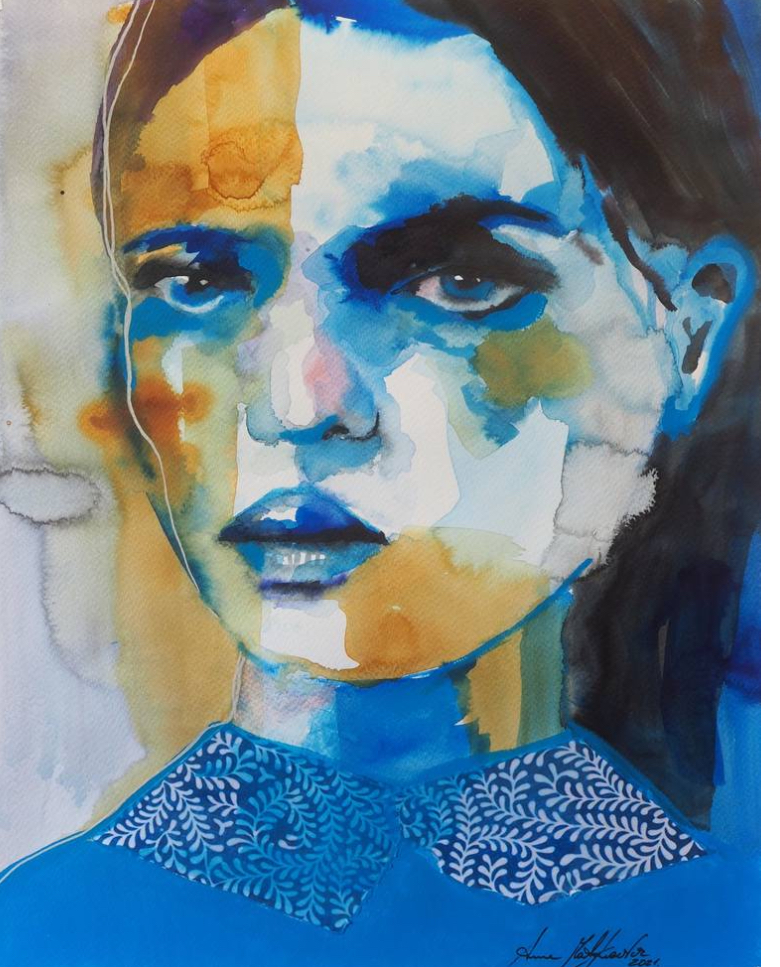Girl in Blue Mood by Polish artist Anna Mattykiewicz is an evocative painting that captures the complexity of human emotion, particularly through its use of color, composition, and symbolism. The painting, a portrait of a young woman immersed in shades of blue, embodies themes of melancholy, introspection, and resilience, inviting viewers to explore both personal and universal experiences of emotional depth. Mattykiewicz, known for her use of expressive color and textured brushwork, achieves a profound impact through subtle techniques and deliberate choices, crafting a piece that resonates deeply with the viewer.
At first glance, the defining characteristic of Girl in Blue Mood is its striking use of blue tones, which dominate the canvas and evoke a sense of calmness tempered by sadness. The color blue, often associated with serenity and melancholy, becomes a tool for the artist to explore a specific mood or psychological state. Mattykiewicz uses various shades, from deep navy to soft azure, layering these tones in a way that suggests depth, both visually and emotionally. The intensity of the color choices immediately draws the viewer into the internal world of the subject, suggesting that her “blue mood” is not merely a temporary feeling but a profound state of being.
The composition centers on the girl, who occupies much of the canvas, facing slightly away from the viewer, her gaze downward and her expression pensive. This positioning creates an intimate moment of solitude, allowing the viewer to observe her without intruding. Mattykiewicz uses this isolated positioning to enhance the sense of introspection. The figure’s body language—her lowered head, averted eyes, and delicate pose—speaks volumes about her emotional state. This composition choice also creates a sense of distance; the viewer is close enough to feel the weight of the girl’s sadness but far enough to respect the privacy of her thoughts.
The background is minimalist, further drawing attention to the subject. This absence of detail in the environment suggests that her internal world is of utmost importance in the painting, reinforcing the focus on her introspective state. In stripping away any distractions, Mattykiewicz allows viewers to focus entirely on the girl’s emotional landscape, accentuated by the monochromatic palette.
The use of blue extends beyond mere aesthetic choice; it serves as a symbol of melancholy, introspection, and perhaps even resilience. In art history, blue has been used to signify a range of emotions, from spiritual calm to somber reflection, and here it embodies both tranquility and isolation. By bathing the subject in blue, Mattykiewicz effectively captures the essence of a “blue mood”—a state of sadness that is not necessarily distressing but rather reflective and meditative. The girl’s expression, solemn but not anguished, indicates a peaceful acceptance of her emotional state. This exploration of melancholy aligns with the Romantic tradition, where sadness is often seen as a complex, layered emotion that reveals deeper truths about the human condition.
The girl’s averted gaze is another symbolic element, suggesting she is lost in thought, perhaps contemplating a memory or a past experience. This introspective pose is a key component of the painting’s psychological impact, as it invites viewers to empathize with her emotional journey. Her expression hints at resilience; while she appears vulnerable, she also seems composed, almost as if she has found a way to coexist with her sadness. This interplay of vulnerability and strength is a recurring theme in Mattykiewicz’s work, where characters often appear to reconcile themselves with their inner worlds.
Furthermore, the choice to make the subject a young woman adds layers of meaning. The portrayal of female introspection and emotional depth often challenges societal expectations of femininity and stoicism. By choosing to depict a woman experiencing and expressing her sadness, Mattykiewicz offers a quiet form of resistance against narratives that marginalize or trivialize women’s emotional experiences.
Mattykiewicz’s technique—characterized by textured brushstrokes and meticulous layering—contributes significantly to the painting’s emotional resonance. Her brushwork, visible upon closer inspection, creates a subtle sense of movement within the piece. The layers of blue blend into one another, almost as if they are enveloping the subject, suggesting that the mood or emotion she experiences is all-encompassing. This technique adds a tactile quality to the painting, reinforcing the tangible weight of her emotions.
By avoiding overly smooth or polished lines, Mattykiewicz leaves room for imperfections, lending a sense of authenticity to the portrait. The textured brushstrokes contribute to the rawness of the girl’s emotional state, as if her feelings are too complex to be captured in a perfectly smooth surface. This approach reflects the artist’s ability to marry technical skill with emotional expression, as she uses the very texture of the painting to echo the roughness of human experience.
Mattykiewicz’s use of light and shadow within the monochromatic palette is also noteworthy. Though primarily in blue, the painting subtly varies in tone, with certain areas highlighted to draw attention to specific features—her face, her hands, and parts of her clothing. These lighter shades create focal points, guiding the viewer’s eye to the areas where the girl’s emotions are most palpable. This delicate interplay of light and dark not only adds dimension to the piece but also evokes the contrast between moments of clarity and the pervasive fog of melancholy.
Beyond its visual appeal, Girl in Blue Mood speaks to themes of solitude and the quiet resilience that often accompanies introspective sadness. The painting reflects the artist’s deep understanding of human emotion, especially the kind of sadness that exists in solitude without immediate resolution. Mattykiewicz captures the beauty and complexity of such moments, showing how melancholy can be an intimate experience rather than one that demands external validation or explanation.
This focus on solitude and vulnerability is universal. The girl’s mood, though somber, suggests an inner strength derived from self-reflection. Her introspective posture and calm demeanor imply a level of self-awareness, as though she has found a way to navigate her emotions without becoming overwhelmed. Mattykiewicz does not portray her as fragile; instead, she is resilient, owning her sadness rather than succumbing to it. This nuanced portrayal challenges simplistic interpretations of melancholy and suggests that sadness, too, can be a source of quiet strength.
Girl in Blue Mood by Anna Mattykiewicz is a masterful exploration of the interplay between color, emotion, and introspection. Through her expert use of blue, Mattykiewicz taps into the timeless association between color and mood, using it to draw the viewer into a contemplative experience. The composition, brushwork, and symbolic choices all contribute to a portrait that transcends mere representation and reaches into the emotional depths of the viewer.
In capturing a moment of pensive sadness with such empathy, Mattykiewicz succeeds in creating a universal statement on the human experience. The girl’s quiet solitude resonates with anyone who has ever experienced moments of self-reflection or found peace in introspection. While her blue mood may suggest melancholy, it is far from despair. Instead, it represents the beauty and resilience that can be found in accepting, rather than avoiding, one’s emotions.
Ultimately, Girl in Blue Mood exemplifies Mattykiewicz’s ability to convey complex emotions through minimalist compositions. It is a painting that invites viewers to pause, to reflect, and to recognize that, sometimes, there is strength to be found in moments of solitude and quiet sadness. The piece is not only a visual achievement but also an emotional one, standing as a testament to the power of art to connect deeply with human feelings and to offer solace in the shared experience of being.
No comments yet.








